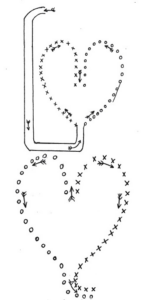Not having any more convenient descriptions of cotillion (dance party game) figures with leap year themes in books of such figures, I have to take them where I find them — in this case, in a description of a society leap year ball attended by no fewer than seven foreign ministers of different nations held in Washington, D. C., on March 24, 1892. The ball was described briefly in The New York Times on March 25, 1892. The majority of the short article is taken up by lengthy lists of all the important people who organized and attended the event, but in between, there is a description of a cotillion figure. Interestingly, it was led by two couples simultaneously, from “opposite ends of the hall”.
Dancing was general until 9:30 o’clock, when the cotillion began, led from opposite ends of the hall by Miss Richardson with Mr. William Slack and Miss Stout with Mr. Clifford Richardson. In the selection of the favors the greatest ingenuity had been exercised, and the laughter-provoking devices were highly satisfactory.
Perhaps, sensible of the number of people attending, they were actually running two cotillions in parallel?


